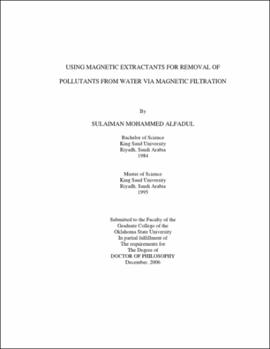| dc.contributor.advisor | Apblett, Allen | |
| dc.contributor.author | Alfadul, Sulaiman Mohammed | |
| dc.date.accessioned | 2013-11-26T08:21:23Z | |
| dc.date.available | 2013-11-26T08:21:23Z | |
| dc.date.issued | 2006-12 | |
| dc.identifier.uri | https://hdl.handle.net/11244/6442 | |
| dc.description.abstract | Scope and Method of Study: The objective of this research was the development of new magnetic methods for the removal of contaminants from water via magnetic filtration. These processes provide several advantages such as extremely rapid separations and remote operation that promotes safety and prevents health problems to workers. Since most of the pollutants in water are weakly magnetic or diamagnetic, they are not amenable to magnetic filtration. For this reason, magnetically-active extractants were synthesized that allow the separation of such species via magnetic filtration. In the first aspect of this research, novel composite materials were synthesized based on iron, hematite, or magnetite for removal of hydrocarbons. The surface of the iron and iron oxides were derivitized with alkylalkoxysilane reagents and siloxane polymers in order to provide hydrophobic active sites for hydrocarbons. All extractants demonstrated excellent performance and reduced the concentration of decane in spiked water to the parts per billon level. Indeed, some extractants showed a powerful ability to extract and remove decane concentration to less than 1 ppb. The second aspect involved the synthesis of coated magnetite nanoparticles prepared by treating magnetite nanoparticles with amino- or mercaptomethoxy-silane. The aminosilsesquioxane extractant was functionalized by a pyridine group. The performance of the synthesized extractants was investigated for the removal of radioactive substances (uranium) and heavy metals (mercury and copper) from water. It was found that the resulting materials were highly effective for purifying water contains these toxic metal ions. In the case of magnetite nanoparticles coated with diaminosilane, the uranium uptake can be as high as 125 % by weight. | |
| dc.description.abstract | Findings and Conclusion: Finally, Novel composite and nanocomposite materials were determined to be excellent single component magnetic filtration aids. The synthesized extractants can also be used for other contaminants and might have other potential applications (e.g. catalysts, drug delivery agents). | |
| dc.format | application/pdf | |
| dc.language | en_US | |
| dc.rights | Copyright is held by the author who has granted the Oklahoma State University Library the non-exclusive right to share this material in its institutional repository. Contact Digital Library Services at lib-dls@okstate.edu or 405-744-9161 for the permission policy on the use, reproduction or distribution of this material. | |
| dc.title | Using magnetic extractants for removal of pollutants from water via magnetic filtration | |
| dc.contributor.committeeMember | Purdie, N. | |
| dc.contributor.committeeMember | Berlin, Kenneth Darrell | |
| dc.contributor.committeeMember | Foutch, Gary Lynn | |
| osu.filename | Alfadul_okstate_0664D_2033 | |
| osu.accesstype | Open Access | |
| dc.type.genre | Dissertation | |
| dc.type.material | Text | |
| thesis.degree.discipline | Chemistry | |
| thesis.degree.grantor | Oklahoma State University | |
